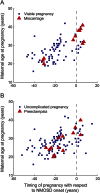Pregnancy outcomes in aquaporin-4-positive neuromyelitis optica spectrum disorder
- PMID: 26581304
- PMCID: PMC4731292
- DOI: 10.1212/WNL.0000000000002208
Pregnancy outcomes in aquaporin-4-positive neuromyelitis optica spectrum disorder
Abstract
Objective: To investigate the association between neuromyelitis optica spectrum disorder (NMOSD) and pregnancy outcome.
Methods: An international cohort of women with aquaporin-4 antibody-positive NMOSD and ≥1 pregnancy was studied retrospectively. Multivariate logistic regression was used to investigate whether pregnancy after NMOSD onset was associated with an increased risk of miscarriage (cohort of 40 women) or preeclampsia (cohort of 57 women).
Results: Miscarriage rate was higher in pregnancies after NMOSD onset (42.9% [95% confidence interval 17.7%-71.1%] vs. 7.04% [2.33%-15.7%]). Pregnancies conceived after, or up to 3 years before, NMOSD onset had an increased odds ratio of miscarriage (7.28 [1.03-51.6] and 11.6 [1.05-128], respectively), independent of maternal age or history of miscarriage. Pregnancies after, or up to 1 year before, NMOSD onset ending in miscarriage were associated with increased disease activity from 9 months before conception to the end of pregnancy, compared to viable pregnancies (mean annualized relapse rate 0.707 vs. 0.100). The preeclampsia rate (11.5% [6.27%-18.9%]) was significantly higher than reported in population studies. The odds of preeclampsia were greater in women with multiple other autoimmune disorders or miscarriage in the most recent previous pregnancy, but NMOSD onset was not a risk factor.
Conclusions: Pregnancy after NMOSD onset is an independent risk factor for miscarriage, and pregnancies conceived at times of high disease activity may be at increased risk of miscarriage. Women who develop NMOSD and have multiple other autoimmune disorders have greater odds of preeclampsia, independent of NMOSD onset timing.
© 2015 American Academy of Neurology.
Figures


References
-
- Wingerchuk DM, Lennon VA, Lucchinetti CF, Pittock SJ, Weinshenker BG. The spectrum of neuromyelitis optica. Lancet Neurol 2007;6:805–815. - PubMed
-
- Yanagawa K, Kawachi I, Toyoshima Y, et al. Pathologic and immunologic profiles of a limited form of neuromyelitis optica with myelitis. Neurology 2009;73:1628–1637. - PubMed
-
- Lennon VA, Wingerchuk DM, Kryzer TJ, et al. A serum autoantibody marker of neuromyelitis optica: distinction from multiple sclerosis. Lancet 2004;364:2106–2112. - PubMed
-
- Cornelio DB, Braga RP, Rosa MW, Ayub AC. Devic's neuromyelitis optica and pregnancy: distinction from multiple sclerosis is essential. Arch Gynecol Obstet 2009;280:475–477. - PubMed
MeSH terms
Substances
LinkOut - more resources
Full Text Sources
Medical
